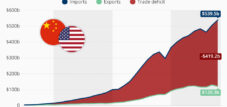Published on: March 29, 2025 / update from: March 29, 2025 - Author: Konrad Wolfenstein

AI boom in China or is the AI bubble bursting now? Hundreds of new data centers are empty - picture: Xpert.digital
Billion-dollar investment, zero demand: China's AI data center debacle
From the gold rush to the crisis: what is behind China's empty AI factories
The first signs of a burst AI bubble show up in China. While recently invested massively in data centers, many of these new facilities are now unused. Between 2023 and 2024, over 500 data center projects were started, but according to media reports, up to 80 percent of the newly created computing capacities remain unused. At the same time, the once flourishing black market for Nvidia chips has cooled down, and more efficient AI models such as Deepseek R1 have the previous business model of many data centers.
Suitable for:
- The AI quake: Deepseek R1 reveals the weaknesses of the tech industry-is that the end of the AI boom?
The boom of the AI data centers in China
The expansion of the AI infrastructure was declared a national priority in China to establish the country as a leading AI location. With state support and private investments, hundreds of new data centers were created in a short time. In 2023 and 2024 alone, over 500 new data center projects were announced across the country-from inner Mongolia to Guangdong.
This development followed the publication of Chatgpt at the end of 2022, which triggered a quick reaction in China. The central government asked local authorities to accelerate the establishment of so-called “smart computing centers”-a term for AI-focused data centers. According to the China Communications Industry Association Data Center Committee, at least 150 of the new data centers were completed and in operation by the end of 2024.
Misdirected investments and lack of expertise
A fundamental problem of this development was the lack of experience of many investors. Companies from non-specialist industries such as the food and textile industry jumped on the AI trend without taking into account the complex requirements. In addition, dodgy middlemen led to inefficient projects by manipulating demand forecasts in order to sclee government subsidies.
Xiao Li, a former real estate entrepreneur who became a project manager for data centers, describes how he was attracted by the AI boom in 2023. At that time, retailers in his Wechat groups bragged about having secured deliveries from high-performance Nvidia GPUs that were actually subject to US export restrictions. At the height of the demand, a single NVIDIA H100 chip, which is essential for the training of AI models, was able to achieve up to 200,000 yuan (approx. $ 28,000) on the black market.
The current crisis: empty data centers
Today, many of the newly built data centers are unused. According to reports from contractors, a manager of a GPU server company and project managers, most operators of these data centers are fighting for survival. Chinese media such as Jiazi Guangnian and 36kr report that up to 80 percent of the newly built computing capacities remain unused.
The rental of GPUs to companies that need them for training AI models-the main business model of the new data centers-was once considered a safe bet. But with the rise of Deepseek and a sudden change in the economy of AI applications, the industry falter.
Prevention of price and desperate seller
The GPU rental price fell to a record low. A current report by the Chinese media company Zhineng Yongxian shows that an NVIDIA H100 server, which is configured with eight GPUs, is now rented for 75,000 yuan per month-a significant decline of around 180,000 yuan. Many data centers prefer to leave their systems empty than take the risk of further losses because the operation is extremely expensive.
This situation is also reflected in the Wechat groups that Xiao Li observes. The dealers have become discredited in their shops, and prices have returned to a normal level. At the same time, two data center projects known to him have difficulty securing further financing from investors who expect small returns. This forces the project managers to sell excess GPUs. "It seems that everyone is selling but buying a few," he says.
The Deepseek effect: Innovation is changing the market
The AI market took a remarkable turn with the rise of Deepseek, a Chinese Ki startup. At the end of January 2025, the company released its AI language models Deepseek-R1-Zero and Deepseek-R1, which were trained with a fraction of the computing effort, which is used for comparable western models.
This development triggered a real shock on the financial markets. Tech shares, especially the chip manufacturer Nvidia, recorded massive losses. On a single day, Deepseek destroyed market values of more than one billion dollar. Nvidia's shares lost $ 17% or $ 589 billion on this day - the highest daily loss in the history of the stock exchange.
Suitable for:
- China's AI revolution for 6 million dollars: DeepSeek challenges the dominance of Nvidia, OpenAI, Google, Meta & Co
Efficiency instead of computing power
The reason for this dramatic market reaction lies in the efficiency of the Deepseek model. It was “amazingly cheap and trained with less advanced chips” and can still keep up with the performance of Openais Chatgpt. This questions the status quo of AI development: "Why invest trillions in new Large Language models if low millions are sufficient for their development?"
This development has fundamentally changed the demand for AI infrastructure. "Deepseek is a moment of billing for the Chinese AI industry. The burning question of 'Who can develop the best large Language Model?' To 'who can better use it?' moved, ”explains Hangcheng Cao, assistant professor for information systems at Emory University.
Technological change in AI development
The rise of Reasoning models such as Deepseek R1 and Openais Chatgpt O1 and O3 has led to a fundamental change in the requirements for data centers. With these technologies, most of the computing effort no longer arises during training and creating the model, but when carrying out step -by -step logical derivations in response to user inquiries.
New requirements for the infrastructure
This reasoning process often provides better results, but takes significantly more time. Therefore, hardware with low latency (the time that needs data to get from one point in the network to another) is of the utmost importance. Data centers must be located near important technology centers in order to minimize transmission delays and to ensure access to highly qualified operating and maintenance staff.
This change means that many data centers that were built in central, west and rural regions of China-where electricity and land are cheaper-are losing attractiveness for AI companies. In Zhengzhou, a city in the province of Henan, a newly built data center even distributes free arithmetic vouchers to local technology companies, but still has difficulty attracting customers.
In addition, many of the new data centers for pret training workloads were optimized-large, continuous calculations that are carried out on massive data sets-and not for inference, the process of taking execution, the Reasoning models trained in real time.
Suitable for:
The global AI race: China vs. USA
The current state of the Chinese AI data centers must be considered in the context of the global race to the management position in the field of artificial intelligence. China has sought a leading position since 2017 with its AIT Generation Artificial Intelligence Development (AIDP). The promotion of AI is considered crucial for the country's competitiveness and national security.
Strategic positioning and investments
In contrast, the United States still has a clear lead in AI investments. Almost $ 70 billion was invested by private companies in the United States last year to develop artificial intelligence - nine times more than in China. With the number of new AI startups, the United States also runs with almost 900 companies compared to 122 in China.
The United States is further strengthening its position. Donald Trump recently announced the “Stargate” project, a 500 billion dollar project for new AI data centers in Texas. Under this name, Openai, Softbank and Oracle want to build up to 20 mega data centers in the coming years in order to advance AI applications and set standards.
China's answer to US sanctions
A special challenge for China is the US export restrictions for advanced semiconductors. Despite these restrictions, China has made considerable progress in AI development. Former US trade minister Gina Raimondo said at the end of 2024 that delivery blocks for ultra-fast chips were only “Speed Bumper” and that it was unsuccessful love effort to stop China's rise.
Deepseek's successes show that Chinese companies find innovative ways to develop competitive AI models with less advanced chips-a reaction to the restrictions of access to top technology.
China's focus on AI: ways to technological independence
Despite the current challenges, the Chinese central government adheres to its support for the AI infrastructure. At the beginning of 2025 she organized a AI industry symposium, in which the importance of self-sufficiency in this technology was emphasized.
Consolidation and government interventions
Experts assume that government agencies can take control of some of the failed projects and hand them over to more experienced operators. "The Chinese government will probably intervene, take over and hand it over to more capable operators," says Jimmy Goodrich, Senior Advisor for Technology on the Rand Corporation.
Large Chinese technology groups continue to invest in AI infrastructure to secure their competitiveness. Alibaba Group has announced plans to invest over $ 50 billion in cloud computing and AI hardware infrastructure in the next three years, while Bytedance plans to invest around $ 20 billion in GPUs and data centers.
Lessons from the Chinese AI bladder
The current situation of the AI data centers in China shows the risks of hasty investments in a rapidly developing technological area. What was considered a safe investment a few years ago was questioned by innovative developments such as Deepseek R1 and changed market conditions.
The growing difficulties of the Chinese AI industry are largely the result of inexperienced actors-companies and local governments-that have jumped on the hype train and have built facilities that are not optimal for today's needs. This experience underlines the importance of specialist knowledge and strategic planning in AI infrastructure development.
A consolidation of the market is indicated for the future, whereby more successful models like Deepseek may pave the way for more efficient and cheaper AI developments. The crucial question has shifted from pure computing power to the meaningful application of AI technology: “What is between today and a future in which AI is actually everywhere is no longer the infrastructure, but solid plans for the use of technology”.
Suitable for:
Your global marketing and business development partner
☑️ Our business language is English or German
☑️ NEW: Correspondence in your national language!
I would be happy to serve you and my team as a personal advisor.
You can contact me by filling out the contact form or simply call me on +49 89 89 674 804 (Munich) . My email address is: wolfenstein ∂ xpert.digital
I'm looking forward to our joint project.














